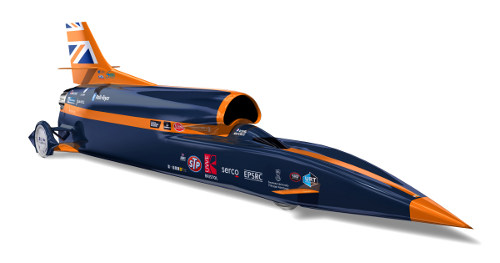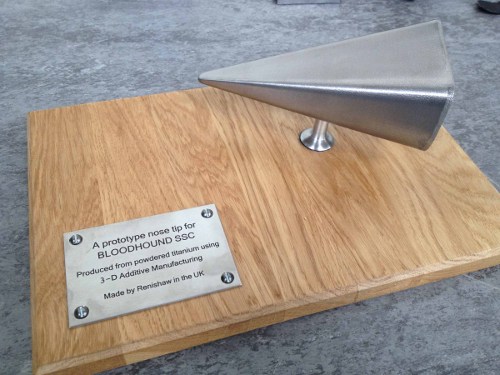 |
| August 06, 2013 | Volume 09 Issue 29 |
Designfax weekly eMagazine
Archives
Partners
Manufacturing Center
Product Spotlight
Modern Applications News
Metalworking Ideas For
Today's Job Shops
Tooling and Production
Strategies for large
metalworking plants
Wheels:
Supersonic car getting 3D-printed nose
British additive manufacturing specialist Renishaw is contributing its machine and materials knowledge to create key prototype parts for the U.K.'s BLOODHOUND supersonic car, which will attempt to break the 1,000-mph speed barrier during the summer of 2015.

One of the most critical components is the nose tip for the car, which will be the very first part to break through any new land speed record. The tip is subject to forces as high as 4,915 lb/ft2. To cope with such loads, a prototype tip has been designed in titanium and will be bonded to BLOODHOUND's carbon fiber monocoque body that forms the front half of the car.
Renishaw is providing a manufacturing resource to the project team to produce the nose tip with its laser-melting machines, which use an additive manufacturing process to fuse together very thin layers of fine metallic powders to form highly complex, functional components. The prototype will be used by the BLOODHOUND team to evaluate possible manufacturing processes and carry out further engineering analysis.
"We believe that the key benefit of using an additive manufacturing process to produce the nose tip is the ability to create a hollow, but highly rigid titanium structure, and to vary the wall thickness of the tip to minimize weight," says Dan Johns, lead engineer at BLOODHOUND SSC responsible for materials, processes, and technologies. "To machine this component conventionally would be extremely challenging, result in design compromises, and waste as much as 95 percent of the expensive raw material."

On July 4, the Rt. Hon. David Willetts, MP, U.K. Minister for Universities and Science, formally opened the new BLOODHOUND Technical Center in Avonmouth, Bristol, England, where the iconic car is now being assembled. He also announced a $1.5 million grant from the Engineering and Physical Sciences Research Council (EPSRC) to support the BLOODHOUND Project's education and outreach mission, which aims to inspire children about STEM subjects. During his visit, Willetts was presented with a special commemorative plaque containing a prototype nose tip manufactured by Renishaw on one of its AM250 additive manufacturing machines.
"With 3D printing having such a high profile in the media and political circles, it is fantastic that the only U.K. manufacturer of a metal-based additive manufacturing machine is able to contribute to this iconic British project," says Simon Scott, director of Renishaw's Additive Manufacturing Products Division. "It aims to inspire a new generation of engineers here and around the world."
You can read a little more background on this project in a 2008 Designfax article here.
Some impressive video about the BLOODHOUND SSC's aluminum wheels
Video: Cisco Bloodhound TV visited sponsor Otto Fuchs in Germany to see the first stage of the 1,000-mph wheels being made.
Read more about the BLOODHOUND SSC project by clicking here.
Source: Renishaw
Published August 2013
Rate this article
View our terms of use and privacy policy
